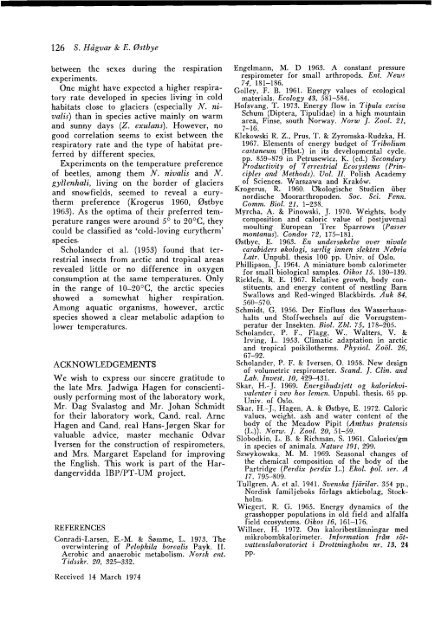Full-text - Norsk entomologisk forening
Full-text - Norsk entomologisk forening
Full-text - Norsk entomologisk forening
You also want an ePaper? Increase the reach of your titles
YUMPU automatically turns print PDFs into web optimized ePapers that Google loves.
etween the sexes during the respiration<br />
ex~eriments.<br />
One might have expected a higher respiratory<br />
rate developed in species living in cold<br />
habitats close to glaciers (especially N. nivalis)<br />
than in species active mainly on warm<br />
and sunny days (Z. exulans). However, no<br />
good correlation seems to exist between the<br />
respiratory rate and the type of habitat preferred<br />
by different species.<br />
Experiments on the temperature preference<br />
of beetles. amonE " them N. nivalis and N.<br />
gyllenhali, living on the border of glaciers<br />
and snowfields, seemed to reveal a eurytherm<br />
preference (Krogerus 1960, 0stbye<br />
1963). As the optima of their preferred temperature<br />
ranges were around 5' to 20°C, they<br />
could be classified as 'cold-loving eurytherm'<br />
species.<br />
Scholander et al. (1953) found that terrestrial<br />
insects from arctic and tropical areas<br />
revealed little or no difference in oxygen<br />
consumption at the same temperatures. Only<br />
in the range of 10-20°C, the arctic species<br />
showed a somewhat higher respiration.<br />
Among aquatic organisms, however, arctic<br />
species showed a clear metabolic adaption to<br />
lower temperatures.<br />
ACKNOWLEDGEMENTS<br />
We wish to express our sincere gratitude to<br />
the late Mrs. Jadwiga Hagen for conscientiously<br />
performing most of the laboratory work,<br />
Mr. Dag Svalastog and Mr. Johan Schmidt<br />
for their laboratory work, Cand. real. Arne<br />
Hagen and Cand. real Hans-Jergen Skar for<br />
valuable advice, master mechanic Odvar<br />
Iversen for the construction of respirometers,<br />
and Mrs. Margaret Espeland for improving<br />
the English. This work is part of the Hardangervidda<br />
IBPIPT-UM project.<br />
REFERENCES<br />
Conradi-Larsen, E.-M. & ~smme, L. 1973. The<br />
overwintering of Pelophila borealis Payk. 11.<br />
Aerobic and anaerobic metabolism. <strong>Norsk</strong> ent.<br />
Tidsskr. 20, 325-332.<br />
Engelmann, M. D 1963. A constant pressure<br />
respirometer for small arthro~ods. Ent. News<br />
74, 181-186.<br />
Golley, F. B. 1961. Energy values of ecological<br />
materials. Ecology 43, 581-584.<br />
Hofsvang, T. 1973. Energy flow in Tipula excisa<br />
Schum (Diptera, Tipulidae) in a high mountain<br />
area, Finse, south Norway. Norw J. Zool. 21,<br />
7-16.<br />
Klekowski R. Z., Prus, T. & Zyromska-Rudzka, H.<br />
1967. Elements of energy budget of 7ribolium<br />
castaneum (Hbst.) in its developmental cycle.<br />
pp. 859-879 in Petrusewicz, K. (ed.) Secondary<br />
Productiuity of Terrest~ial Ecosystems (Principles<br />
and Methods). Vol. II. Polish Academy<br />
of Sciences. Warszawa and Kraków.<br />
Krogerus, R. 1960. Dkologische Studien über<br />
nordische Moorarthro~oden. Soc. Scz. Fenn.<br />
Comm. Biol. 21, 1-238'.<br />
Mvrcha, A. & Pinowski. T. 1970. Weiphts, bodv<br />
composition and calorir value of ~ostjuvenál<br />
moulting European Tree Sparrows (Passer<br />
montanus). Condor 72, 175-181.<br />
astbye, E. 1963. En undersekelse ouer niuale<br />
carabiders okologi, scerlig innen slekten Neb~ia<br />
Latr. Unpubl. thesis 100 pp. Univ. of Oslo.<br />
Phillipson, J. 1964. A miniature bomb calorimeter<br />
for small biological samples. Oikos 15, 130-139.<br />
Ricklefs, R. E. 1967. Relative growth, body constituents,<br />
and energy content of nestling Barn<br />
Swallows and Red-winged Blackbirds. Auk 84,<br />
560-570.<br />
Schmidt, G. 1956. Der Einfluss des Wasserhaushalts<br />
und Stoffwechsels auf die Vorzugstemperatur<br />
der Insekten. Biol. Lbl. 75, 178-205.<br />
Scholander, P. F., Flagg, W., Walters, V. &<br />
Irving, L. 1953. Climatic adaptation in arctic<br />
and tropical poikilotherms. Physiol. Zool. 26,<br />
67-92.<br />
Scholander, P. F. & Iversen, 0. 1958. New design<br />
of volumetric respirometer. Scand. J. Clin. and<br />
Lab. Invest. 10, 429-43 1.<br />
Skar, H.-J. 1969. Energibzidsjett og kaloriekvivalenter<br />
i uev hos lemen. Unpubl. thesis. 65 pp.<br />
Univ. of Oslo.<br />
Skar, H.-J., Hagen, A. & nstbye, E. 1972. Caloric<br />
values, weicht. ash and water content of the<br />
body bf the Meadow Pipit (Anthus firatensis<br />
(L.)). Norw. J. Zool. 20, 51-59.<br />
Slobodkin. L. B. & Richman. S. 1961. Calories/m<br />
in speciks of animals. Nathre 191, 299.<br />
Szwykowska, M. M. 1969. Seasonal changes of<br />
the chemical com~osition of the bodv of the<br />
Partridge (perdixLperdix L.) Ekol. #;l. ser. A<br />
17, 795-809.<br />
Tullgren, A. et al. 1941. Svenska fjarilar. 354 pp.<br />
Nordisk familjeboks forlags aktiebolag, Stockholm.<br />
Wiegert, R. G. 1965. Energy dynamics of the<br />
grasshopper populations in old field and alfalfa<br />
field ecosystems. Oikos 16, 161-176.<br />
Willner, H. 1972. Om kaloribestamningar med<br />
mikrobombkalorimeter. Information fran S&-<br />
uattenslaboratoriet i Drottningholm n7. 13. 24<br />
PP.<br />
"<br />
Received 14 March 1974

















